Jason Schneider
the Camera Collector
What’s the best U.S.-made interchangeable lens rangefinder 35?
Depends on what “best,” means and whether it’s a “system” camera!
By Jason Schneider
When I first started musing over this conundrum, I thought I knew the answer, but it turns out that the “best camera” isn’t as easy to define as one might think. For a country that prides itself on its industrial might and world class technology the United States of America isn’t so hot when it comes to manufacturing high performance cameras. The Speed Graphic is a well-made workhorse, but it’s no Linhof. And Polaroid’s ingenuity and Kodak’s mass marketing genius aside, we’ve never produced a rangefinder 35 of the overall caliber as a Leica M3 or a Nikon SP. We love to pee all over the Russians for their clunky cameras and questionable quality control (except for their lenses which are generally pretty good), but where is the American made 35mm SLR or DSLR, medium format SLR, et al. The Russkys and Chinese make all these things, but we don’t.
Such was not the case just before WWII or in the immediate postwar years, when there was a dearth of precision Gernan 35mm cameras and Anerican entrepreneurs and camera companies saw an opportunity and jumped in. What follows is a brief recap of 6 fascinating American attempts to build a high-quality interchangeable lens 35. Spoiler alert: three of the cameras overed here were unreliable and/or underperformers, so they didn’t cut it despite their ingenuity and pluck, That leaves the Bell & Howell Foton, a brilliant and reliable machine that was never developed into the great system it could have been, the masterfully crafted Kardon a de facto system camera but one designed and conceived as a mass-production Leica copy, and the unassuming little ol’ Argus C44/C44R, the second-best-selling American-made interchangeable lens rangefinder 35 of all time with the notable exception of that immortal clunker, the Argus C3, which had uncoupled film wind and shutter cocking functions and the slowest, least convenient system of lens interchangeability ever invented!
The Argus C44/C44R: Most successful U.S.-made system rangefinder 35
The Argus C44 is an American-made 35mm interchangeable lens 35mm rangefinder camera that was in production from 1956-1957 before it was replaced by the C44R (1958-1962) that added a two-stroke film wind lever in place of the knob used on the C44, and a rewind crank instead of a rewind knob. The camera has a hot shoe and switch for M or X sync, the frame counter counts down and must be manually reset once a fresh roll of film is inserted, it offers the option of using a cable release, and has a tripod socket located slightly off center to the lens. The shutter is a behind the lens leaf type with speeds of 1/10 - 1/300 sec plus B and is adjusted via a dial located on the front of the camera. The C44R has geometric shutter speeds of 1/8, 1/15. 1/30, 1/60, 1/125 and 1/300 sec plus B, and late examples if the C44R have a smooth top plate with an inset rather than protruding rewind crank. Six lenses were produced for the C44, with the most common being the excellent Tessar type Cintagon 50mm f/2.8 which was manufactured in Ann Arbor, Michigan. Rewinding of film is accomplished by lifting the wind knob and giving it a slight turn to keep it in the lifted position, then turning the re-wind knob until the frame counter stops turning.
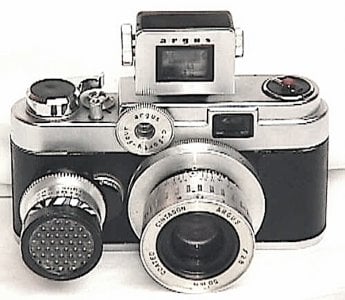
The Argus C44R, late model with rewind crank faired into smooth top plate. Note uncoupled selenium meter attachment and shoe-mount viewfinder for 35mm and 100mm lenses. This leaf shuttered beauty is no Leica or Contax, but it was serviceable and had good lenses.
The C44’s bayonet lens mount has been the subject of much scathing criticism, but I think this is vastly overblown. While the Argus lens mount is a bit “fiddly” compared to, say, a Leica M mount, it’s commendably straightforward once you get used to it. To remove the lens, set everything to infinity, press the release latch below the lens and twist the lens 90 degrees counter-clockwise, and off it comes. To mount a lens, line up the red dots on the lens and the mount, seat the lens, twist 90 degrees clockwise and it clicks nicely into place. Likewise, the shutter has been compared to the sound of a mousetrap going off, but this is hardly the case. It's not as quiet as a Prontor or Compur, but it's quieter than many focal plane shutters I can think of, and on a par with several other leaf shutters I have used. The camera has the usual Argus rangefinder/focus system coupled to the milled wheel on the front, a limited range of shutter speeds; 1/10, 1/25, 1/50, 1/100 and 1/300 plus B on the plain C44, a film wind/shutter cocking knob that seems to rotate forever, and an overall feel of great solidity. It's a well-built camera, but in places it has the mediocre finish typical of many American cameras (e.g. the accessory shoe), and it has several clunky round-headed screws that would be anathema to any European manufacturer. The interior is neat, the alloy castings are solid, and the removable bottom/back facilitates film loading.
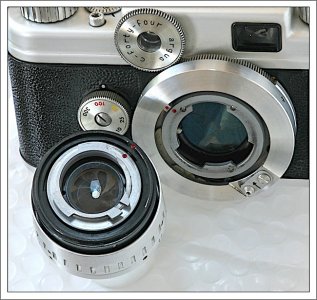
The C Forty-Four's robust 3-lobe bayonet mount was widely panned as being too wonky, but it's not bad once you get used to it. You do have to remember to line up the red dots on the lens and the mount as shown but once you do, removing and mounting lenses is no big deal.
After the Geiss company produced a modified version of the Argus C4 which permitted interchangeable lenses, Argus followed suit with the C44 (inscribed "C Forty-four" on the camera itself) and the new model camera shared the same basic body as the C4, including that model's improved rangefinder/viewfinder. The only real difference was in the lenses. The standard Cintagon 50mm f/2.8 was the first 4-element lens (Tessar-type) that the Ann Arbor factory turned out and is said to have been designed with the help of an early digital computer, 'MIDAC,' belonging to the University of Michigan. Three other focal lengths were offered, a 50mm f/1.9; 35mm f/4.5 and 100mm, all manufactured by Steinheil in Germany, to a somewhat higher standard of finish, and branded Cintagon. On a C44 lens, the fluting is not a focusing ring (confusingly, it is only the lens flange in the body that rotates to focus). However, grabbing the fluted section does assist in attaching and removing the lens with a short twist. The standard lens is natively threaded for Series V filters and hoods. The 35mm and 100mm lenses take Series VI accessories (and unfortunately for polarizer users, they rotate as you focus). There’s no rewind button; you lift and twist the film advance knob to rewind.
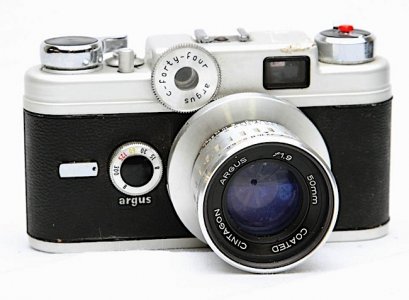
Early version of the Argus C44R with stepped top is shown here with rare 50mm f/1.9 Cintagon lens made by Steinheil in Germany.
The Argus C44, and the slightly tweaked C44R, were the last, and generally considered the best in a long line of Argus 35mm scale focusing and rangefinder cameras. It’s no Leica, or Nikon, Canon, but it has a decent combined range/viewfinder, a reliable shutter an (admittedly limited) array of high-quality lenses and is capable if first class results. Its Achilles heel is not, as you might think, the external gear-coupled rangefinder system which seldom causes trouble, but the in-body focusing helical which almost invariably requires professional service (de-lubrication, cleaning, and re-lubrication) to function smoothly. And while I don’t have any production stats you may rest assured that the sales of Argus C44’s and C44R’s far exceed those for the Bell & Howell Foton or the Kardon, the only other contenders for “Best American interchangeable lens rangefinder 35” honors. Best of all, you can snag one of these beauties with excellent 50mm f/2.8 Cintagon lens for about 50 to 60 bucks which IMHO is a bargain.
The Kardon: The American “Leica.” Best made U.S. “system” 35!
The Kardon, often referred to as the “American Leica” was the brainchild of Peter Kardon, a Russian immigrant, naturalized U.S, citizen, and president of the Premier Instrument Company of New York. He was patriotically motivated to produce a high-quality 35mm rangefinder camera that was desperately needed by the U.S. Signal Corps during WWII when Leicas were no longer available. As a subcontractor to E. Leitz, New York (which the U.S. government had seized in 1941) and using their production equipment, he tried to fulfill a contact for 6,000 Made in U.S.A “Leica IIIa” cameras. However, he soon realized that the equipment at Leitz was in poor condition, and that he’d have to redesign the camera for mass production using standardized parts instead of precision bench assembly. This would also allow easier repair in the field. The entire Kardon family took part in the project and the result was the Kardon camera, manufactured in several versions from 1945-1954.
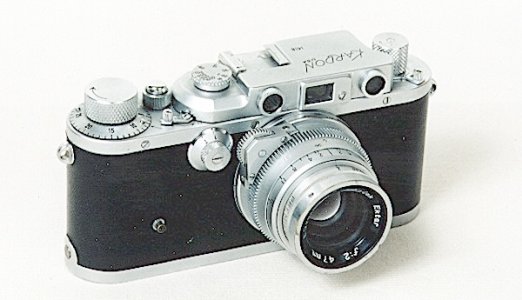
The Kardon: This is the civilian version with Leica-style film wind knob, Note Contax-style milled focusing wheel on superb 47mm f/2 Ektar lens.
The camera was indeed an ingeniously simplified, eminently functional “Leica” based on the parameters of the Leica IIIa, but made in the U.S.A. The horizontal cloth focal-plane shutter provided shutter speeds of 1-1/1000 sec with speeds of 1/20 sec and slower set on a separate front-mounted dial. The coated screw-mount lens used was the acclaimed 47mm f/2 Ektar manufactured by Kodak in Rochester, NY that delivered outstanding imaging performance. It included a distinctive Contax-like milled focusing wheel connected to the geared focusing helical in place of the traditional Leica focusing tab with infinity lock. Unfortunately for Premier Instrument Company, the government cancelled the contract in 1945 once Japan surrendered, just as military production was getting underway, and Kardon tried to bring the camera to the civilian market to recoup his substantial investment costs in, dies, tooling, etc.
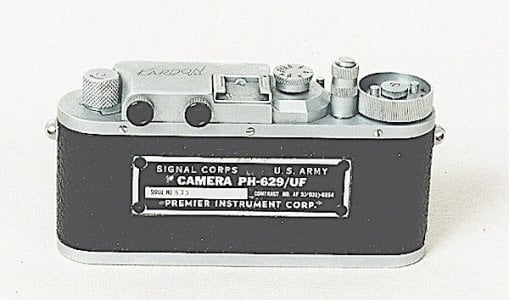
Back view of military Kardon shows U.S. Army Signal Corps I.D. Plate. Note oversized film wind knob operable with gloved hands.
The civilian Kardon was unveiled in 1947 at $393 retail, $175 wholesale, but these prices could be easily undercut by German camera makers including Leica, that benefitted from lower labor costs and financial support under the Marshall plan. As a result, the beautifully made Kardon was a technical success, but a commercial failure, with only a couple of thousand having been sold over the counter. Today, the Kardon is a rare collector’s prize that typically fetches about $1,500 to $2,000 with 50mm f/2.0 Ektar lens, and about $1,000, body only. The Kardon is technically a de facto system camera because it accepts and couples with a vast array of Leica screw mount (LTM) lenses, but as an unabashed Leica copy it hardly qualifies as an original American design. It will always stand as a lasting testament to American ingenuity.
The Bell & Howell Foton: The best American rangefinder 35 that really worked, it never became the world-class system it could have been
The fabulous Bell & Howell Foton of 1948 qualifies as the last and most successful attempt to build a world-class, interchangeable lens 35mm rangefinder camera in the U.S. In purely technical terms, it was probably the most successful, but unlike its German and Japanese competitors it was never conceived as a full system camera. With its blistering top framing rate of 6 fps, It could have benefitted from a bulk film back or interchangeable magazines, but none was forthcoming, and only a handful of lenses (at extravagant prices) were ever offered for it, a 4-inch (100mm) T4, a 4-inch f/2.5, a 6-inch tele and (according to a contemporary NY Times article), a 35mm f/3.5 wide-angle that nobody has ever seen. All carried the Cooke label, were made by the venerable English lens maker Taylor, Taylor, and Hobson, and featured aluminum barrels.
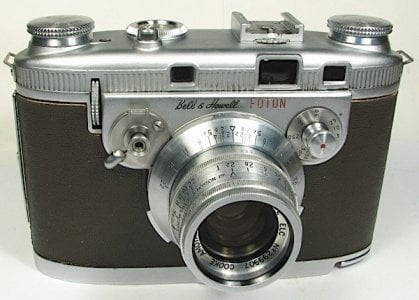
Bell & Howell Foton with 2-inch T2.2 Cooke Amotal lens by Taylor, Taylor & Hobson. This spring motor drive classic could shoot bursts at up to 6 frames per sec, a feature that made it popular with sports photographers. Unfortunately, it was very expensive and the market was too small.
The Foton’s most striking characteristics are its spring-motor drive and its unique vertical-travel metal focal plane shutter consisting of two hinged “pleated” blades that form the slit, plus a pair pivoted capping blades behind the lens to protect the film while the shutter is re-cocking. This ingenious combo permitted sequences at up to 6 frames per sec (!) with 10-15 exposures per wind. Other features: Robust cast alloy body, long-base, high magnification rangefinder with separate viewfinder, and a front-mounted vertical focusing wheel (it only worked with 2-inch and shorter lenses; telephotos had to be focused by turning the focusing ring on the barrel).
The camera also featured a frontward-pointing shutter release, and a separate, single front-mounted shutter dial for setting all speeds 1-1/000 sec plus B. The bayonet mount, alloy-barrel TT &H Taylor telephoto lenses, and the screw-mount normal lens were all calibrated in T- (light transmission) stops for inherently superior exposure accuracy. Attractive, well balanced, beautifully made and finished, and reliable, the large, heavy and expensive ($695) Foton was popular with pro sports photographers (most were reportedly sold to Life Magazine photographers), but the Foton sold in insufficient numbers and was discontinued in 1950, only 2 years after its introduction. Collector’s price with T/2.2 Cooke Amotal lens, about $2,500. Complete kit: approximately $5,000.
The Kodak Ektra: An audacious design with a duff shutter!
The Kodak Ektra of 1941 was Kodak’s first and last attempt to build the finest interchangeable-lens rangefinder camera the world had ever seen, and they poured an enormous amount of resources into the project. The result, designed primarily Joseph Mihaly was technically brilliant, spectacular, and in many ways functional, but it was also extraordinarily complex, expensive to manufacture, featured a left-handed shutter release, film-advance crank, and front-mounted focusing wheel. Legend has it that this was because Mihaly was a southpaw, but it turns out he wasn’t. Unfortinately the Ektra’s ingenious shutter was notoriously unrerliable despite various attempts to improve it and that, even more than the camera’s extremely high selling price, prevented it from ever fulfilling its potential as an alternative to the Leica and Contax.
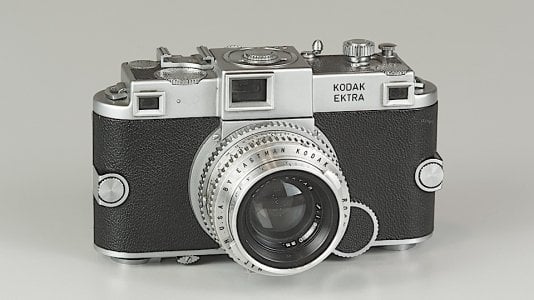
The Ektra of 1941: Kodak's first and last attempt to build the world's top pro 35mm rangefinder camera was festooned with advanced features like interchangeable film backs, and sported a stunning array of Ektar lenses but was doomed by shutter woes and a stratospheric price.
The Ektra’s amazing features include: A 4-1/8-inch-base, high magnification, full-military-spec split-image rangefinder, a separate varifocal dioptric viewfinder positioned directly over the lens to minimize parallax error, and a full range of superb breech-lock bayonet mount Ektar lenses ranging from from 35mm to 153mm. It also had interchangeable film magazines, each with a with built-in, two-stroke film-advance lever, a folding rewind crank, and a rubberized cloth focal-plane shutter with fast-and slow-speed dials providing speeds of 1-1/1000 sec plus B. Standard lens was a 50mm f/1.9 or f/3.5 Ektar. Since Kodak officially sold only 2,490 Ektras to the public before it was discontinued in 1948 and each one used 667 different parts made of 88 different materials in its construction, Kodak evidently lost a pile of money on the project. Ektras are unreliable as picture takers (the shutter was never perfected and the film backs are trouble prone) but it is a magnificent and beautifully conceived collectible that is a lasting tribute to what might have been the best American 35mm rangefinder camera of all time. Current value with 50mm f/1.9 Ektar lens: about $2,500; under $2,000 with 50mm f/3.5 Ektar.
The Clarus MS-35: Elegant style meets mediocre build quality,
The Clarus Model MS-35 is an interchangeable lens 35mm rangefinder camera made from 1946-1952 by the Clarus Camera Manufacturing Company of Minneapolis. Designed by Paul Mann, it was the only camera model made by that company, and its inexperience resulted in a camera beset with quality control and reliability issues that never achieved its full potential. It was a sophisticated design with a coupled rangefinder and separate viewfinder, a hprizontal cloth focal plane shutter with speeds 1/25-1/1000 +B, and the Clarus screw mount for interchangeable lenses. Standard lenses were a Wollensak Anastigmat 2 inch (50mm) f/2.8 triplet or a Tessar type Wollensak Velostigmat 2 inch f/2.8. Other available lenses were Elgeet 4 inch, a Wollensak 101mm f/3.5, a Wollensak 35mm f/3.5 and a rare Wollensak Raptar 2 inch f/2.0.
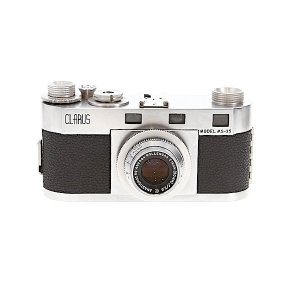
Clarus MS-35 with 50mm f./2.8 Wollensak Anastigmat lens: Elegantly proportioned, full featured, and reasonably priced, this American beauty was plagued by poor design, mediocre construction, and unreliability resulting from the company's inexperience in building cameras.
The shutter speed dial rotates during exposure, and must be lifted fir setting, features common to many cameras in the ‘40s, and the camera lacks a self-timer or flash sync, the latter added in later production models. The frame counter is manually reset, and film advance can be awkward since the shutter release guard is placed too close to the film wind knob. The shutter release does double duty as the film rewind button, and it must be held in while rewinding. Early models have an elegant accessory shoe consisting of two separate castings, but later models are fitted with a conventional one-piece shoe.
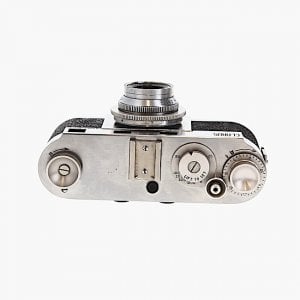
Top view of Clarus MS-35 shows single rotating shutter dial with speeds of 1/25 to 1/1000 sec. Note separate eyepieces for the rangefinder and viewfinder visible at the bottom of the photo.
The camera appears to have been rushed into production to meet the tremendous post-war demand for cameras. The initial 20,000 cameras produced between 1946 and 1948 suffered from such egregious design and manufacturing problems that, despite having fixed these problems by 1949, the widespread reputation of the cameras as a dismal failure doomed both the MS-35 and the company that produced it.
As Mather Broms, Clarus' last general manager, assessed the company, “Clarus represented a magnificent opportunity for great success slipping through the fingers of a group of grossly inexperienced, poorly financed people, saddled with a camera whose basic design was a complete failure - in the beginning.”
You can snag a clean “functional” Clarus for about $40-75 with standard 50mm f/2.8 Wollensak lens and around $150 to $100 with the 50mm f/2 Wollensak Raptar.
The Perfex 55: Great idea, but poor design and so-so execution
The Perfex 55, was the last and most advanced iteration of the interchangeable lens 35mm rangefinder series made by the Candid Camera Corporation of Chicago, a company formed by Carl and Joseph Price and Benjamine Edelman in 1938 to make an upgraded competitor to the wildly successful Argus A, a simple spartan 35mm point and shoot that debuted in 1936. They believed that offering an upgraded American-made camera with interchangeable lenses, a focal plane shutter, and a built-in meter was bound to be a hit and make them rich. Despite having an outstanding feature set, it didn’t. All Perfex models were plagued with design faults, questionable workmanship, and so-so dependability making picture taking an unintentional adventure.
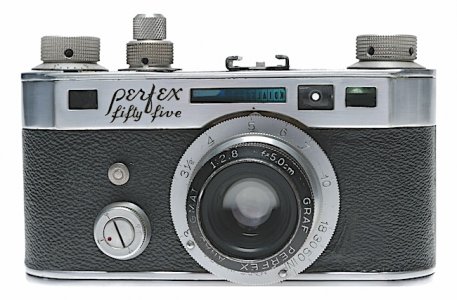
The Perfex Fifty-Five: Last and most advanced if the Perfex line it sure looked like a precision camera and its focal plane shutter had speeds of 1 to 1/1250 sec plus B, edging out the Leica IIIa and Contax II, but it was no paragon or reliability and had the worst back lock system ever!
The first Perfex, the Speed Candid of 1938, was the first American 35mm camera with a focal plane shutter, and it provided speeds of 1/25. 1/50, 1/100, 1/200, and 1/500 sec plus B, had a (non-Leica- compatible 38mm) screw mount, and a 50mm f/3.5 or 50mm f/2.8 Graf Perfex Anastigmat normal lens. A 150mm f/4.5 telephoto was also available, and all these lenses were evidently manufactured by General Scientific Corp. of Chicago. Unfortunately, the body was an ungainly amalgam of Bakelite and metal, and the built-in exposure meter was of the not-too-accurate extinction type that varied depending on the eye of the observer. It did offer a ground glass focusing accessory and extension tubes for close-ups.
The follow-up Perfex Forty-four was a considerable advance over the rarish Speed Candid and it established the “precision look” body style with removable back for easy loading that was used on all subsequent Perfex models. The interchangeable screw mount lenses were the same ones offered on the Speed Candid, but its focal plans shutter provided speeds of 1 sec to 1/1250 sec plus B, exceeding those of the Leica (which topped out at 1/1000 sec) and the Contax (which only got down to ½ sec). Remarkably, the Perfex 44 even had a hot shoe for flash bulbs. The black trimmed Perfex Thirty-three of 1940 had no slow speeds.
The Perfex Fity-five is essentially a further refined version of the Forty-Four. It also was introduced in 1940 along with the Thirty-Three. This model survived WWII and was discontinued in 1947. Early models include the extinction meter that was used on the Forty-Four and Thirty-Three models, while later models delete this feature. Shutter speeds range from 1 second to 1/1250 second, with slow speeds (1, 1/2, 1/5, 1/10 second, and B) being accessed by a separate dial on the face of the camera. The slow speed dial must be wound in addition to the normal shutter winding. As noted above, this arrangement was also used on late model Forty-Four cameras, as that model was phased out.
The Fifty-Five was offered with one of four different standard lenses, listed in order of original cost from lowest to highest:
2-inch f/3.5 Scienar
2-inch f/3.5 Wollensak Perfex Velostigmat
2-inch f/2.8 Scienar
2-inch f/2.8 Wollensak Perfex Velostigmat
Also offered were a 6-inch f/4.5 and a 4-inch f/4.5 telephoto. The 6-inch lens was fitted with a special "micromatic focusing mount". Other accessories that were available for this camera were a Perfex Flash Gun, a range of lens extension tubes from 11/32-inch up to 6-inch, and a leather "eveready" case.
Note: According to Stephen Gandy late model Perfexes deserve the Worst Film Back Locking Design Award because the back locks, which rotate in opposite directions, can rotate out of position thereby preventing the locked back from being removed “without spending a happy half hour or more to get the back off.” Delightful! If you’re a masochist, you can currently acquire a clean, working Perfex Fifty-five (or Forty-four) for around $50-75, higher for models in mint condition or with extra lenses, viewfinders, etc.
Depends on what “best,” means and whether it’s a “system” camera!
By Jason Schneider
When I first started musing over this conundrum, I thought I knew the answer, but it turns out that the “best camera” isn’t as easy to define as one might think. For a country that prides itself on its industrial might and world class technology the United States of America isn’t so hot when it comes to manufacturing high performance cameras. The Speed Graphic is a well-made workhorse, but it’s no Linhof. And Polaroid’s ingenuity and Kodak’s mass marketing genius aside, we’ve never produced a rangefinder 35 of the overall caliber as a Leica M3 or a Nikon SP. We love to pee all over the Russians for their clunky cameras and questionable quality control (except for their lenses which are generally pretty good), but where is the American made 35mm SLR or DSLR, medium format SLR, et al. The Russkys and Chinese make all these things, but we don’t.
Such was not the case just before WWII or in the immediate postwar years, when there was a dearth of precision Gernan 35mm cameras and Anerican entrepreneurs and camera companies saw an opportunity and jumped in. What follows is a brief recap of 6 fascinating American attempts to build a high-quality interchangeable lens 35. Spoiler alert: three of the cameras overed here were unreliable and/or underperformers, so they didn’t cut it despite their ingenuity and pluck, That leaves the Bell & Howell Foton, a brilliant and reliable machine that was never developed into the great system it could have been, the masterfully crafted Kardon a de facto system camera but one designed and conceived as a mass-production Leica copy, and the unassuming little ol’ Argus C44/C44R, the second-best-selling American-made interchangeable lens rangefinder 35 of all time with the notable exception of that immortal clunker, the Argus C3, which had uncoupled film wind and shutter cocking functions and the slowest, least convenient system of lens interchangeability ever invented!
The Argus C44/C44R: Most successful U.S.-made system rangefinder 35
The Argus C44 is an American-made 35mm interchangeable lens 35mm rangefinder camera that was in production from 1956-1957 before it was replaced by the C44R (1958-1962) that added a two-stroke film wind lever in place of the knob used on the C44, and a rewind crank instead of a rewind knob. The camera has a hot shoe and switch for M or X sync, the frame counter counts down and must be manually reset once a fresh roll of film is inserted, it offers the option of using a cable release, and has a tripod socket located slightly off center to the lens. The shutter is a behind the lens leaf type with speeds of 1/10 - 1/300 sec plus B and is adjusted via a dial located on the front of the camera. The C44R has geometric shutter speeds of 1/8, 1/15. 1/30, 1/60, 1/125 and 1/300 sec plus B, and late examples if the C44R have a smooth top plate with an inset rather than protruding rewind crank. Six lenses were produced for the C44, with the most common being the excellent Tessar type Cintagon 50mm f/2.8 which was manufactured in Ann Arbor, Michigan. Rewinding of film is accomplished by lifting the wind knob and giving it a slight turn to keep it in the lifted position, then turning the re-wind knob until the frame counter stops turning.

The Argus C44R, late model with rewind crank faired into smooth top plate. Note uncoupled selenium meter attachment and shoe-mount viewfinder for 35mm and 100mm lenses. This leaf shuttered beauty is no Leica or Contax, but it was serviceable and had good lenses.
The C44’s bayonet lens mount has been the subject of much scathing criticism, but I think this is vastly overblown. While the Argus lens mount is a bit “fiddly” compared to, say, a Leica M mount, it’s commendably straightforward once you get used to it. To remove the lens, set everything to infinity, press the release latch below the lens and twist the lens 90 degrees counter-clockwise, and off it comes. To mount a lens, line up the red dots on the lens and the mount, seat the lens, twist 90 degrees clockwise and it clicks nicely into place. Likewise, the shutter has been compared to the sound of a mousetrap going off, but this is hardly the case. It's not as quiet as a Prontor or Compur, but it's quieter than many focal plane shutters I can think of, and on a par with several other leaf shutters I have used. The camera has the usual Argus rangefinder/focus system coupled to the milled wheel on the front, a limited range of shutter speeds; 1/10, 1/25, 1/50, 1/100 and 1/300 plus B on the plain C44, a film wind/shutter cocking knob that seems to rotate forever, and an overall feel of great solidity. It's a well-built camera, but in places it has the mediocre finish typical of many American cameras (e.g. the accessory shoe), and it has several clunky round-headed screws that would be anathema to any European manufacturer. The interior is neat, the alloy castings are solid, and the removable bottom/back facilitates film loading.

The C Forty-Four's robust 3-lobe bayonet mount was widely panned as being too wonky, but it's not bad once you get used to it. You do have to remember to line up the red dots on the lens and the mount as shown but once you do, removing and mounting lenses is no big deal.
After the Geiss company produced a modified version of the Argus C4 which permitted interchangeable lenses, Argus followed suit with the C44 (inscribed "C Forty-four" on the camera itself) and the new model camera shared the same basic body as the C4, including that model's improved rangefinder/viewfinder. The only real difference was in the lenses. The standard Cintagon 50mm f/2.8 was the first 4-element lens (Tessar-type) that the Ann Arbor factory turned out and is said to have been designed with the help of an early digital computer, 'MIDAC,' belonging to the University of Michigan. Three other focal lengths were offered, a 50mm f/1.9; 35mm f/4.5 and 100mm, all manufactured by Steinheil in Germany, to a somewhat higher standard of finish, and branded Cintagon. On a C44 lens, the fluting is not a focusing ring (confusingly, it is only the lens flange in the body that rotates to focus). However, grabbing the fluted section does assist in attaching and removing the lens with a short twist. The standard lens is natively threaded for Series V filters and hoods. The 35mm and 100mm lenses take Series VI accessories (and unfortunately for polarizer users, they rotate as you focus). There’s no rewind button; you lift and twist the film advance knob to rewind.

Early version of the Argus C44R with stepped top is shown here with rare 50mm f/1.9 Cintagon lens made by Steinheil in Germany.
The Argus C44, and the slightly tweaked C44R, were the last, and generally considered the best in a long line of Argus 35mm scale focusing and rangefinder cameras. It’s no Leica, or Nikon, Canon, but it has a decent combined range/viewfinder, a reliable shutter an (admittedly limited) array of high-quality lenses and is capable if first class results. Its Achilles heel is not, as you might think, the external gear-coupled rangefinder system which seldom causes trouble, but the in-body focusing helical which almost invariably requires professional service (de-lubrication, cleaning, and re-lubrication) to function smoothly. And while I don’t have any production stats you may rest assured that the sales of Argus C44’s and C44R’s far exceed those for the Bell & Howell Foton or the Kardon, the only other contenders for “Best American interchangeable lens rangefinder 35” honors. Best of all, you can snag one of these beauties with excellent 50mm f/2.8 Cintagon lens for about 50 to 60 bucks which IMHO is a bargain.
The Kardon: The American “Leica.” Best made U.S. “system” 35!
The Kardon, often referred to as the “American Leica” was the brainchild of Peter Kardon, a Russian immigrant, naturalized U.S, citizen, and president of the Premier Instrument Company of New York. He was patriotically motivated to produce a high-quality 35mm rangefinder camera that was desperately needed by the U.S. Signal Corps during WWII when Leicas were no longer available. As a subcontractor to E. Leitz, New York (which the U.S. government had seized in 1941) and using their production equipment, he tried to fulfill a contact for 6,000 Made in U.S.A “Leica IIIa” cameras. However, he soon realized that the equipment at Leitz was in poor condition, and that he’d have to redesign the camera for mass production using standardized parts instead of precision bench assembly. This would also allow easier repair in the field. The entire Kardon family took part in the project and the result was the Kardon camera, manufactured in several versions from 1945-1954.

The Kardon: This is the civilian version with Leica-style film wind knob, Note Contax-style milled focusing wheel on superb 47mm f/2 Ektar lens.
The camera was indeed an ingeniously simplified, eminently functional “Leica” based on the parameters of the Leica IIIa, but made in the U.S.A. The horizontal cloth focal-plane shutter provided shutter speeds of 1-1/1000 sec with speeds of 1/20 sec and slower set on a separate front-mounted dial. The coated screw-mount lens used was the acclaimed 47mm f/2 Ektar manufactured by Kodak in Rochester, NY that delivered outstanding imaging performance. It included a distinctive Contax-like milled focusing wheel connected to the geared focusing helical in place of the traditional Leica focusing tab with infinity lock. Unfortunately for Premier Instrument Company, the government cancelled the contract in 1945 once Japan surrendered, just as military production was getting underway, and Kardon tried to bring the camera to the civilian market to recoup his substantial investment costs in, dies, tooling, etc.

Back view of military Kardon shows U.S. Army Signal Corps I.D. Plate. Note oversized film wind knob operable with gloved hands.
The civilian Kardon was unveiled in 1947 at $393 retail, $175 wholesale, but these prices could be easily undercut by German camera makers including Leica, that benefitted from lower labor costs and financial support under the Marshall plan. As a result, the beautifully made Kardon was a technical success, but a commercial failure, with only a couple of thousand having been sold over the counter. Today, the Kardon is a rare collector’s prize that typically fetches about $1,500 to $2,000 with 50mm f/2.0 Ektar lens, and about $1,000, body only. The Kardon is technically a de facto system camera because it accepts and couples with a vast array of Leica screw mount (LTM) lenses, but as an unabashed Leica copy it hardly qualifies as an original American design. It will always stand as a lasting testament to American ingenuity.
The Bell & Howell Foton: The best American rangefinder 35 that really worked, it never became the world-class system it could have been
The fabulous Bell & Howell Foton of 1948 qualifies as the last and most successful attempt to build a world-class, interchangeable lens 35mm rangefinder camera in the U.S. In purely technical terms, it was probably the most successful, but unlike its German and Japanese competitors it was never conceived as a full system camera. With its blistering top framing rate of 6 fps, It could have benefitted from a bulk film back or interchangeable magazines, but none was forthcoming, and only a handful of lenses (at extravagant prices) were ever offered for it, a 4-inch (100mm) T4, a 4-inch f/2.5, a 6-inch tele and (according to a contemporary NY Times article), a 35mm f/3.5 wide-angle that nobody has ever seen. All carried the Cooke label, were made by the venerable English lens maker Taylor, Taylor, and Hobson, and featured aluminum barrels.

Bell & Howell Foton with 2-inch T2.2 Cooke Amotal lens by Taylor, Taylor & Hobson. This spring motor drive classic could shoot bursts at up to 6 frames per sec, a feature that made it popular with sports photographers. Unfortunately, it was very expensive and the market was too small.
The Foton’s most striking characteristics are its spring-motor drive and its unique vertical-travel metal focal plane shutter consisting of two hinged “pleated” blades that form the slit, plus a pair pivoted capping blades behind the lens to protect the film while the shutter is re-cocking. This ingenious combo permitted sequences at up to 6 frames per sec (!) with 10-15 exposures per wind. Other features: Robust cast alloy body, long-base, high magnification rangefinder with separate viewfinder, and a front-mounted vertical focusing wheel (it only worked with 2-inch and shorter lenses; telephotos had to be focused by turning the focusing ring on the barrel).
The camera also featured a frontward-pointing shutter release, and a separate, single front-mounted shutter dial for setting all speeds 1-1/000 sec plus B. The bayonet mount, alloy-barrel TT &H Taylor telephoto lenses, and the screw-mount normal lens were all calibrated in T- (light transmission) stops for inherently superior exposure accuracy. Attractive, well balanced, beautifully made and finished, and reliable, the large, heavy and expensive ($695) Foton was popular with pro sports photographers (most were reportedly sold to Life Magazine photographers), but the Foton sold in insufficient numbers and was discontinued in 1950, only 2 years after its introduction. Collector’s price with T/2.2 Cooke Amotal lens, about $2,500. Complete kit: approximately $5,000.
The Kodak Ektra: An audacious design with a duff shutter!
The Kodak Ektra of 1941 was Kodak’s first and last attempt to build the finest interchangeable-lens rangefinder camera the world had ever seen, and they poured an enormous amount of resources into the project. The result, designed primarily Joseph Mihaly was technically brilliant, spectacular, and in many ways functional, but it was also extraordinarily complex, expensive to manufacture, featured a left-handed shutter release, film-advance crank, and front-mounted focusing wheel. Legend has it that this was because Mihaly was a southpaw, but it turns out he wasn’t. Unfortinately the Ektra’s ingenious shutter was notoriously unrerliable despite various attempts to improve it and that, even more than the camera’s extremely high selling price, prevented it from ever fulfilling its potential as an alternative to the Leica and Contax.

The Ektra of 1941: Kodak's first and last attempt to build the world's top pro 35mm rangefinder camera was festooned with advanced features like interchangeable film backs, and sported a stunning array of Ektar lenses but was doomed by shutter woes and a stratospheric price.
The Ektra’s amazing features include: A 4-1/8-inch-base, high magnification, full-military-spec split-image rangefinder, a separate varifocal dioptric viewfinder positioned directly over the lens to minimize parallax error, and a full range of superb breech-lock bayonet mount Ektar lenses ranging from from 35mm to 153mm. It also had interchangeable film magazines, each with a with built-in, two-stroke film-advance lever, a folding rewind crank, and a rubberized cloth focal-plane shutter with fast-and slow-speed dials providing speeds of 1-1/1000 sec plus B. Standard lens was a 50mm f/1.9 or f/3.5 Ektar. Since Kodak officially sold only 2,490 Ektras to the public before it was discontinued in 1948 and each one used 667 different parts made of 88 different materials in its construction, Kodak evidently lost a pile of money on the project. Ektras are unreliable as picture takers (the shutter was never perfected and the film backs are trouble prone) but it is a magnificent and beautifully conceived collectible that is a lasting tribute to what might have been the best American 35mm rangefinder camera of all time. Current value with 50mm f/1.9 Ektar lens: about $2,500; under $2,000 with 50mm f/3.5 Ektar.
The Clarus MS-35: Elegant style meets mediocre build quality,
The Clarus Model MS-35 is an interchangeable lens 35mm rangefinder camera made from 1946-1952 by the Clarus Camera Manufacturing Company of Minneapolis. Designed by Paul Mann, it was the only camera model made by that company, and its inexperience resulted in a camera beset with quality control and reliability issues that never achieved its full potential. It was a sophisticated design with a coupled rangefinder and separate viewfinder, a hprizontal cloth focal plane shutter with speeds 1/25-1/1000 +B, and the Clarus screw mount for interchangeable lenses. Standard lenses were a Wollensak Anastigmat 2 inch (50mm) f/2.8 triplet or a Tessar type Wollensak Velostigmat 2 inch f/2.8. Other available lenses were Elgeet 4 inch, a Wollensak 101mm f/3.5, a Wollensak 35mm f/3.5 and a rare Wollensak Raptar 2 inch f/2.0.

Clarus MS-35 with 50mm f./2.8 Wollensak Anastigmat lens: Elegantly proportioned, full featured, and reasonably priced, this American beauty was plagued by poor design, mediocre construction, and unreliability resulting from the company's inexperience in building cameras.
The shutter speed dial rotates during exposure, and must be lifted fir setting, features common to many cameras in the ‘40s, and the camera lacks a self-timer or flash sync, the latter added in later production models. The frame counter is manually reset, and film advance can be awkward since the shutter release guard is placed too close to the film wind knob. The shutter release does double duty as the film rewind button, and it must be held in while rewinding. Early models have an elegant accessory shoe consisting of two separate castings, but later models are fitted with a conventional one-piece shoe.

Top view of Clarus MS-35 shows single rotating shutter dial with speeds of 1/25 to 1/1000 sec. Note separate eyepieces for the rangefinder and viewfinder visible at the bottom of the photo.
The camera appears to have been rushed into production to meet the tremendous post-war demand for cameras. The initial 20,000 cameras produced between 1946 and 1948 suffered from such egregious design and manufacturing problems that, despite having fixed these problems by 1949, the widespread reputation of the cameras as a dismal failure doomed both the MS-35 and the company that produced it.
As Mather Broms, Clarus' last general manager, assessed the company, “Clarus represented a magnificent opportunity for great success slipping through the fingers of a group of grossly inexperienced, poorly financed people, saddled with a camera whose basic design was a complete failure - in the beginning.”
You can snag a clean “functional” Clarus for about $40-75 with standard 50mm f/2.8 Wollensak lens and around $150 to $100 with the 50mm f/2 Wollensak Raptar.
The Perfex 55: Great idea, but poor design and so-so execution
The Perfex 55, was the last and most advanced iteration of the interchangeable lens 35mm rangefinder series made by the Candid Camera Corporation of Chicago, a company formed by Carl and Joseph Price and Benjamine Edelman in 1938 to make an upgraded competitor to the wildly successful Argus A, a simple spartan 35mm point and shoot that debuted in 1936. They believed that offering an upgraded American-made camera with interchangeable lenses, a focal plane shutter, and a built-in meter was bound to be a hit and make them rich. Despite having an outstanding feature set, it didn’t. All Perfex models were plagued with design faults, questionable workmanship, and so-so dependability making picture taking an unintentional adventure.

The Perfex Fifty-Five: Last and most advanced if the Perfex line it sure looked like a precision camera and its focal plane shutter had speeds of 1 to 1/1250 sec plus B, edging out the Leica IIIa and Contax II, but it was no paragon or reliability and had the worst back lock system ever!
The first Perfex, the Speed Candid of 1938, was the first American 35mm camera with a focal plane shutter, and it provided speeds of 1/25. 1/50, 1/100, 1/200, and 1/500 sec plus B, had a (non-Leica- compatible 38mm) screw mount, and a 50mm f/3.5 or 50mm f/2.8 Graf Perfex Anastigmat normal lens. A 150mm f/4.5 telephoto was also available, and all these lenses were evidently manufactured by General Scientific Corp. of Chicago. Unfortunately, the body was an ungainly amalgam of Bakelite and metal, and the built-in exposure meter was of the not-too-accurate extinction type that varied depending on the eye of the observer. It did offer a ground glass focusing accessory and extension tubes for close-ups.
The follow-up Perfex Forty-four was a considerable advance over the rarish Speed Candid and it established the “precision look” body style with removable back for easy loading that was used on all subsequent Perfex models. The interchangeable screw mount lenses were the same ones offered on the Speed Candid, but its focal plans shutter provided speeds of 1 sec to 1/1250 sec plus B, exceeding those of the Leica (which topped out at 1/1000 sec) and the Contax (which only got down to ½ sec). Remarkably, the Perfex 44 even had a hot shoe for flash bulbs. The black trimmed Perfex Thirty-three of 1940 had no slow speeds.
The Perfex Fity-five is essentially a further refined version of the Forty-Four. It also was introduced in 1940 along with the Thirty-Three. This model survived WWII and was discontinued in 1947. Early models include the extinction meter that was used on the Forty-Four and Thirty-Three models, while later models delete this feature. Shutter speeds range from 1 second to 1/1250 second, with slow speeds (1, 1/2, 1/5, 1/10 second, and B) being accessed by a separate dial on the face of the camera. The slow speed dial must be wound in addition to the normal shutter winding. As noted above, this arrangement was also used on late model Forty-Four cameras, as that model was phased out.
The Fifty-Five was offered with one of four different standard lenses, listed in order of original cost from lowest to highest:
2-inch f/3.5 Scienar
2-inch f/3.5 Wollensak Perfex Velostigmat
2-inch f/2.8 Scienar
2-inch f/2.8 Wollensak Perfex Velostigmat
Also offered were a 6-inch f/4.5 and a 4-inch f/4.5 telephoto. The 6-inch lens was fitted with a special "micromatic focusing mount". Other accessories that were available for this camera were a Perfex Flash Gun, a range of lens extension tubes from 11/32-inch up to 6-inch, and a leather "eveready" case.
Note: According to Stephen Gandy late model Perfexes deserve the Worst Film Back Locking Design Award because the back locks, which rotate in opposite directions, can rotate out of position thereby preventing the locked back from being removed “without spending a happy half hour or more to get the back off.” Delightful! If you’re a masochist, you can currently acquire a clean, working Perfex Fifty-five (or Forty-four) for around $50-75, higher for models in mint condition or with extra lenses, viewfinders, etc.
Last edited:
You can learn from bad designs as much, or more- than good ones. Maybe because the problems caused by bad designs are more memorable. Then look at how the function was implemented on a different camera, or even other devices, that did it right.
One American made interchangeable lens rangefinder that I picked up dirt cheap, exceeded expectation: The Kodak Signet 80. Styling reminds me of a '57 Chevy, but it still works. 1x viewfinder, and a quick-load film system that does work. A "Passable" Ektanar, too bad Kodak did not put an Ektar on it. The Ektar 47/2 on my Retina II is 1st rate.
My C44R- the advance lever fell off, and there must be a trick to getting the return spring back in place. that I did not figure out.
Now I want a Kardon.
One American made interchangeable lens rangefinder that I picked up dirt cheap, exceeded expectation: The Kodak Signet 80. Styling reminds me of a '57 Chevy, but it still works. 1x viewfinder, and a quick-load film system that does work. A "Passable" Ektanar, too bad Kodak did not put an Ektar on it. The Ektar 47/2 on my Retina II is 1st rate.
My C44R- the advance lever fell off, and there must be a trick to getting the return spring back in place. that I did not figure out.
Now I want a Kardon.
dexdog
Mentor
Jason, thanks for the article! Sonnar B, the Kardon would be nice, but really i really want the 47/2 Ektar
Tim Murphy
Well-known
Dear Sonnar Brian,You can learn from bad designs as much, or more- than good ones. Maybe because the problems caused by bad designs are more memorable. Then look at how the function was implemented on a different camera, or even other devices, that did it right.
One American made interchangeable lens rangefinder that I picked up dirt cheap, exceeded expectation: The Kodak Signet 80. Styling reminds me of a '57 Chevy, but it still works. 1x viewfinder, and a quick-load film system that does work. A "Passable" Ektanar, too bad Kodak did not put an Ektar on it. The Ektar 47/2 on my Retina II is 1st rate.
My C44R- the advance lever fell off, and there must be a trick to getting the return spring back in place. that I did not figure out.
Now I want a Kardon.
Dang you! Now I have a new watch list on Ebay!
Regards,
Tim Murphy
Harrisburg PA
Mackinaw
Think Different
I bought a Perfex 55 several years back at antiques show. Cost me $5.00 USD, and came with an (exposed) cartridge of B&W inside. I developed the film and managed to come up with some passable neagtives that probably dated back to the 1950's. The camera is a bit rough. Maybe this winter I'll take it apart and get it back in working condition.
Jim B.
Jim B.
wlewisiii
Just another hotel clerk
Interesting to see this article. I had a friend gift me an Argus C3 that is a shelf queen for a number of reasons but it's got me jonesing for a C44. Just the plain one with only the 50/2.8 will do so I can have one with an American made Tessar type designed with a COMPUTER 😈
raydm6
Yay! Cameras! 🙈🙉🙊┌( ಠ_ಠ)┘ [◉"]
Thank you very much for that incredibly detailed and informative article @Jason Schneider.
A lot of work went into that but I’m sure it was a labor of love.
A lot of work went into that but I’m sure it was a labor of love.
Jason Schneider
the Camera Collector
The 50mm f/2.8 Cintagon is a very good lens indeed. I would love to do a field test comparing it with the 50mm f2.8 Leitz Elmar and the 50mm f/3.5 Ektar for the Ektra.Interesting to see this article. I had a friend gift me an Argus C3 that is a shelf queen for a number of reasons but it's got me jonesing for a C44. Just the plain one with only the 50/2.8 will do so I can have one with an American made Tessar type designed with a COMPUTER 😈
wlewisiii
Just another hotel clerk
I would enjoy such a test. Especially since a reasonably priced one has accidentally found it's way into my watch listThe 50mm f/2.8 Cintagon is a very good lens indeed. I would love to do a field test comparing it with the 50mm f2.8 Leitz Elmar and the 50mm f/3.5 Ektar for the Ektra.
I wonder how the Cintagon 50/1.9 compares too...
Hcompton79
Established
Surely the Argus C3 also deserves a mention given the roughly 2 million of them sold over a period of two decades.
neal3k
Well-known
My Kardon with the Ektar lens is really nice but I enjoy the feel of my Leica II and III cameras more, even with 50mm Elmars. But I like it that the Kardon is a "Made in USA" Barnack copy.
zeitz
Established
I didn't see a reference to the Argus C33.
Jason Schneider
the Camera Collector
I did mention the Argus C3 in passing but few would include the lovable “brick” in a list of “best” American made interchangeable lens rangefinder 35s.Surely the Argus C3 also deserves a mention given the roughly 2 million of them sold over a period of two decades.
Jason Schneider
the Camera Collector
I haven't been able to find specs on the 50mm f/1.9 Cintagon, but it's probably based on the Steinheil Quinon design which h is ver good indeed. A clean early version Argus C44R with 50mm f/1.9 Cintagon was recently offered on eBay, but it sold for $192.50, a little too rich for my blood.I would enjoy such a test. Especially since a reasonably priced one has accidentally found it's way into my watch listIf it's still available on my next payday, I'll just have to get it for the fun of it.
I wonder how the Cintagon 50/1.9 compares too...
wlewisiii
Just another hotel clerk
Yeah, I wouldn't go there. The one I'm considering with the 2.8 comes to just under a Grant with tax and shipping. That's still a bit much for what it is but it seems cute enough to risk itI haven't been able to find specs on the 50mm f/1.9 Cintagon, but it's probably based on the Steinheil Quinon design which h is ver good indeed. A clean early version Argus C44R with 50mm f/1.9 Cintagon was recently offered on eBay, but it sold for $192.50, a little too rich for my blood.
KoNickon
Nick Merritt
Well, it's not like there are a lot in this category.I did mention the Argus C3 in passing but few would include the lovable “brick” in a list of “best” American made interchangeable lens rangefinder 35s.
Jason Schneider
the Camera Collector
You don't have to buy a Kardon to get a 47mm f/2 Ektar. It was a (non-interchangeable) option on the Kodak Retina II. The bad news: a clean working Retina II with 47mm f/2 Ektar typically goes for about $600. An original pristine 47mm f/2 Ektar in Leica screw mount (the one with the little milled Contax-style focusing wheel) will set you back about $1,200. Why such high prices? It's not only a great lens, but also a coveted collectible.Jason, thanks for the article! Sonnar B, the Kardon would be nice, but really i really want the 47/2 Ektar
dexdog
Mentor
bought an LTM version from ebay, as you stated it was about 1200 USD
Jason Schneider
the Camera Collector
Mazel Tov. I hope you enjoy the lens and capture many great images with it!bought an LTM version from ebay, as you stated it was about 1200 USD
Dralowid
Michael
If the conversation is drifting on to US made lenses for rangefinders it is worth mentioning those made/assembled/distributed by E Leitz NY. I think I dimly remember a Summar thus marked.
I understand they also made some accessories. Someone more knowledgeable than I (easy) will know more.
I understand they also made some accessories. Someone more knowledgeable than I (easy) will know more.
Share:
-
This site uses cookies to help personalise content, tailor your experience and to keep you logged in if you register.
By continuing to use this site, you are consenting to our use of cookies.

